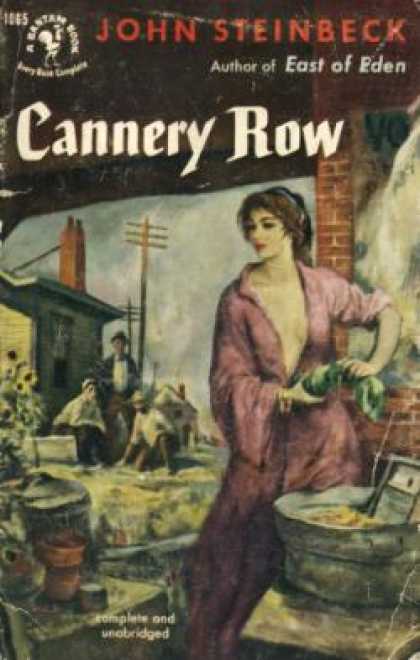
One can read a certain edition of a book then, on the blog post wherein she or he speaks of said book, insert a completely different cover, for certain creative reasons. It is in this freedom that I post the image above, which is not only different from the cover of the book that I read, but is also almost entirely out of touch with the book itself.
But, self, you might be asking yourself, why would he choose such a lurid paperback cover when the book is such a masterful piece of literature?
Fear not. The answer is forthcoming.
The book itself, Cannery Row, is much like a Robert Altman film or a Garrison Keillor book (or a combination thereof). Its structure, if you can call it that, weaves in and out of lives, drawing sketches of immensely interesting characters, then leaving them half-done. John Steinbeck, the author (in case you didn't pick up on that from the picture), returns every other chapter to a narrative thread, but even that seems to move around in its own way.
The book is about a place called Cannery Row in Monterey in California. Or no, it's about the people who inhabit the place. Wait, actually, it's a parody of the American dream. Well, yes and no, it's about how to live freely. Hold on, maybe it is actually about a place called Cannery Row.
We could go in circles like this for pages.
This problem has been facing me in the arts quite a bit lately. A good book or a song or a movie takes however long it takes because it has a lot to do, and it works on so many different levels that summarizing it is next to impossible. Still, we fans keep trying.
The same is true of the Bible, which is a book whose identity I've been reading about quite a bit lately. It seems that if I adopt one view on what it really is, I have to chop it up and filter it and do a lot of analysis that seems a little removed from the heart of the thing. Anyway, I digress.
So the reason I chose a different cover for Steinbeck's book (the other, newer cover shows frogs scattering before a group of hobo types, which could serve as a pretty good hermeneutic key to the whole thing, seeing as how it highlights what is perhaps the central symbol of the book) is to avoid "let's run this through our hermeneutic grid and see what we come up with"-type thinking.
Try the book yourself. I'd say the best approach is to read it for the characters, and let the symbolism and statements bounce around in your head during the aftermath. That's what I did half a week ago, and they're still bouncing around in there, asking me questions, striking chords with my experiences, bringing certain characters to light, and calling me to rethink, rethink, rethink (word repeated for echo-type effect).
No comments:
Post a Comment